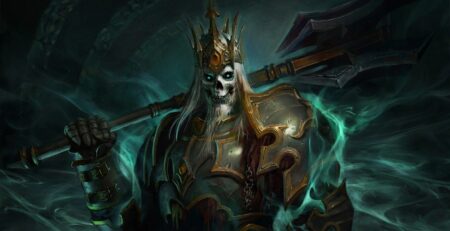
Star Wars would not be what it is without Akira Kurosawa. The legendary director was one of the major influences on George Lucas’ vision of a galaxy far far away, and to this day his work continues to permeate Star Wars films and television projects. With Star Wars Visions making its grand debut this week, I decided to look at how specific films from Akira Kurosawa’s career helped shape the world and characters of Star Wars.
The Hidden Fortress

The Hidden Fortress is perhaps the most important film on this list, as its plot structure and characters serve as the major basis for Star Wars: A New Hope. The 1958 film focuses on peasants Tahei (Minoru Chiaki) and Matashichi (Kamatari Fujiwara) who are roped into escorting Makabe Rokurōta (Toshiro Mifune) and Princess Yuki (Misa Uehara) as they attempt to smuggle gold from Yuki’s Akizuki clan through Japan. George Lucas used The Hidden Fortress as the base for his original outline of A New Hope and took to the idea of telling the story through the eyes of two lowly protagonists.
“The one thing I was really intrigued by was the fact that the story was told from the two lowest characters. I decided that would be a nice way to tell the Star Wars story…That was the strongest influence,” he said in an interview. Tahei and Matashichi would become the droids C-3P0 and R2-D2; Princess Yuki became Princess Leia; General Rokurōta became the Jedi Knight Obi-Wan Kenobi. And in lieu of gold, R2 would carry the secret to toppling the planet-killing Death Star in his memory banks. Lucas had even intended for Mifune, a longtime Akira Kurosawa collaborator, to play Obi-Wan before Alec Guinness took up the role.
Seven Samurai

Perhaps the film that Akira Kurosawa is best known for is 1954’s Seven Samurai-a film that is probably the first thing that springs to mind when people hear the word “samurai”. Seven Samurai centers on a village that hires a group of seven samurai to protect them from a horde of incoming bandits. The film popularized the “assembling a team” sequence that has become a staple of other ensemble films such as its western counterpart The Magnificent Seven and even animated fare like A Bug’s Life. Star Wars would use Seven Samurai as an influence for a number of projects, including episodes of The Mandalorian and Star Wars: The Clone Wars.
The most direct comparison would be Rogue One, which sees Jyn Erso (Felicity Jones) assemble a motley crew in order to steal the plans for the Death Star. In the same way that elder samurai Kambei saves a young child, the Rebel commando Saw Gerrera saves a young Jyn from Imperial forces in Rogue One‘s opening sequence. And Rebel spy Cassian Andor (Diego Luna) ends up assembling a group of warriors including blind monk Chirrut Imwe (Donnie Yen) and Imperial defector Bodhi Rook (Riz Ahmed) to form the titular Rogue One. Zack Snyder (Army of the Dead) was even considering doing a Star Wars take on Seven Samurai back in 2013 that eventually morphed into the upcoming Netflix film Rebel Moon.
Yojimbo

The other film that springs to mind when discussing Akira Kurosawa’s career is Yojimbo, which celebrates its 60th anniversary this year. Yojimbo centers on the ronin Sanjuro (Mifune) who pits two warring crime lords against each other in order to rid a small town of their influence. Sanjuro’s stoic nature, as well as the intense sword-fighting sequences, would give birth to the spaghetti western genre when Sergio Leone remade Yojimbo into A Fistful of Dollars in 1964. Sanjuro has also inspired multiple characters in fiction throughout the years, including Clint Eastwood’s the Man with No Name and Din Djarin from The Mandalorian. Like Sanjuro, Djarin is a man of few words who is highly skilled with weaponry and possesses a strong code of ethics that he adheres to, known as “The Way.” He even finds himself traveling from planet to planet righting wrongs and battling to protect the Force-sensitive child Grogu. Star Wars Visions would even pay homage to Yojimbo with its first episode “The Duel,” which features a Sith swordsman who bears more than a passing resemblance to Sanjuro.
Rashomon
Though it lacks the action that permeates Yojimbo and Seven Samurai, Rashomon has become just as influential due to its unorthodox narrative. Akira Kurosawa centers the film on a samurai’s murder and the assault of his wife, with four different witnesses telling a very different story of the events that transpired in court. Star Wars: The Last Jedi utilizes what is known as “the Rashomon effect” by presenting three different versions of the night Luke Skywalker confronted his nephew Ben Solo, which led to Ben’s transformation into Kylo Ren. Luke at first tells Rey that Ren buried him in rubble and burned down the Jedi temple; Ren counters by revealing that Luke attempted to kill him. The final version shows that Luke did consider striking down his nephew but stood down in shame just as Ben woke up. These conflicting narratives also bring to mind a lesson that Obi-Wan Kenobi imparted to Luke during Return of the Jedi: “You’re going to find that many of the truths we cling to depend greatly on our own point of view.”
Star Wars: Visions has brought the franchise full circle with its debut, as anime studios have put their own spin on the world of Star Wars while highlighting the franchise’s roots in Japanese culture. And with new films and television shows in development, including the upcoming Book of Boba Fett, there is a chance for more of Akira Kurosawa’s films to serve as inspiration to filmmakers and fans alike.
Star Wars: Visions is available exclusively to stream on Disney+.



